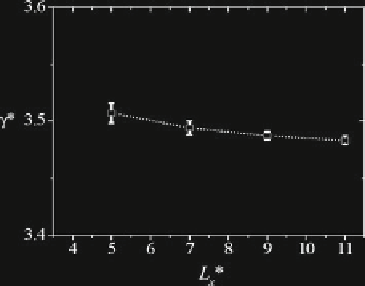Environmental Engineering Reference
In-Depth Information
Fig. 2
Dependence of the
interfacial tension
ʳ
∗
between two immiscible
model fluids as a function of
the size of the simulation
box
. Note that the difference
between the values of the
interfacial tension for the
smallest
and
biggest boxes
amounts to about 1 %. The
axes are drawn in reduced
DPD units. Adapted from
Velázquez et al. (
2006
)
ʺ
−
1
N
−
1
m
k
B
T
a
ii
=
,
(8)
2
ʱˁ
where
N
m
is the coarse-graining degree (number of water molecules grouped in a
DPD particle),
ʱ
=
0
.
101 is a numerical constant,
ˁ
is the DPD number density
ʺ
−
1
and
ʺ
is the dimensionless compressibility of the system. It is defined as
=
1
/∂ˁ
0
)
T
is the usual isothermal compressibility. When one chooses a coarse-graining degree
equal to 3, water molecules in a DPD particle and the water compressibility under
standard conditions,
/(ˁ
0
k
B
T
ʺ
T
)
, where
ˁ
0
is the number density of molecules and
ʺ
T
=
(∂
p
ʺ
−
1
3.
The parameter for different types of particles,
a
ij
, is calculated from the Flory-
Huggins coefficient
16, the DPD force parameter takes the value
a
ii
=
78
.
ˇ
ij
using the following relation:
a
ij
=
a
ii
+
3
.
27
ˇ
ij
.
(9)
ˇ
ij
value can be obtained from the solubility parameters. The remaining forces
of the model, namely the dissipative force and the random force, are exactly as defined
in Eq. (
3
). Because all the conservative forces are repulsive, the equation of state of
DPD is positive definite and it does not have a van der Waals loop (Groot and Warren
1997
). Therefore, it cannot predict liquid-vapor phase transitions. However, this
limitation can be overcome by introducing a local density dependent attractive term
into the conservative force (see Eq.
7
), which is useful for predicting surface tension
(Pagonabarraga and Frenkel
2001
). Among the advantages of the soft potentials used
in DPD is the fact that finite size effects are minimal when the appropriate ensemble
is used because the potentials are also short ranged (Velázquez et al.
2006
). This
allows one to perform accurate simulations using relatively small, computationally
inexpensive systems, as shown in Fig.
2
.
The

Search WWH ::

Custom Search